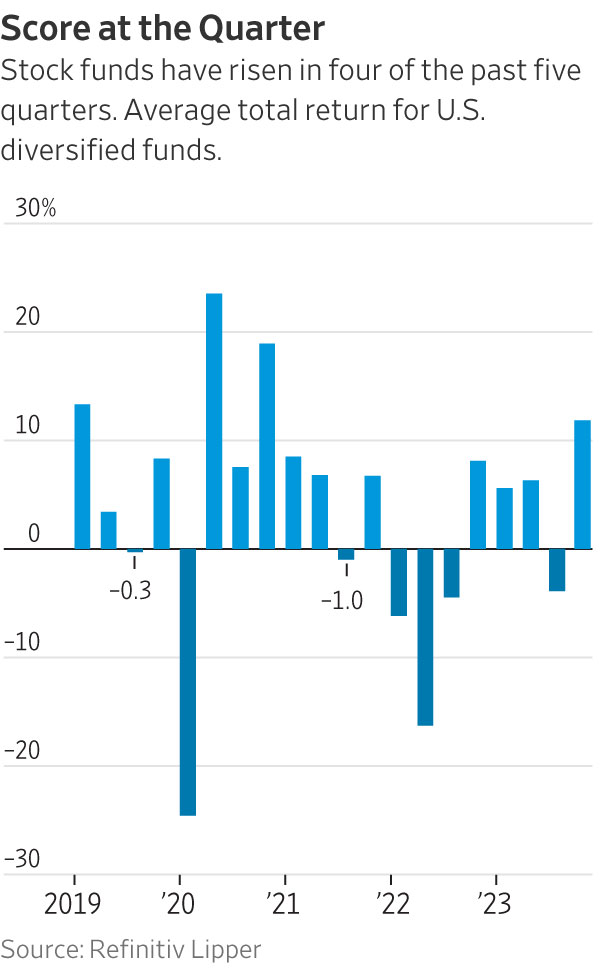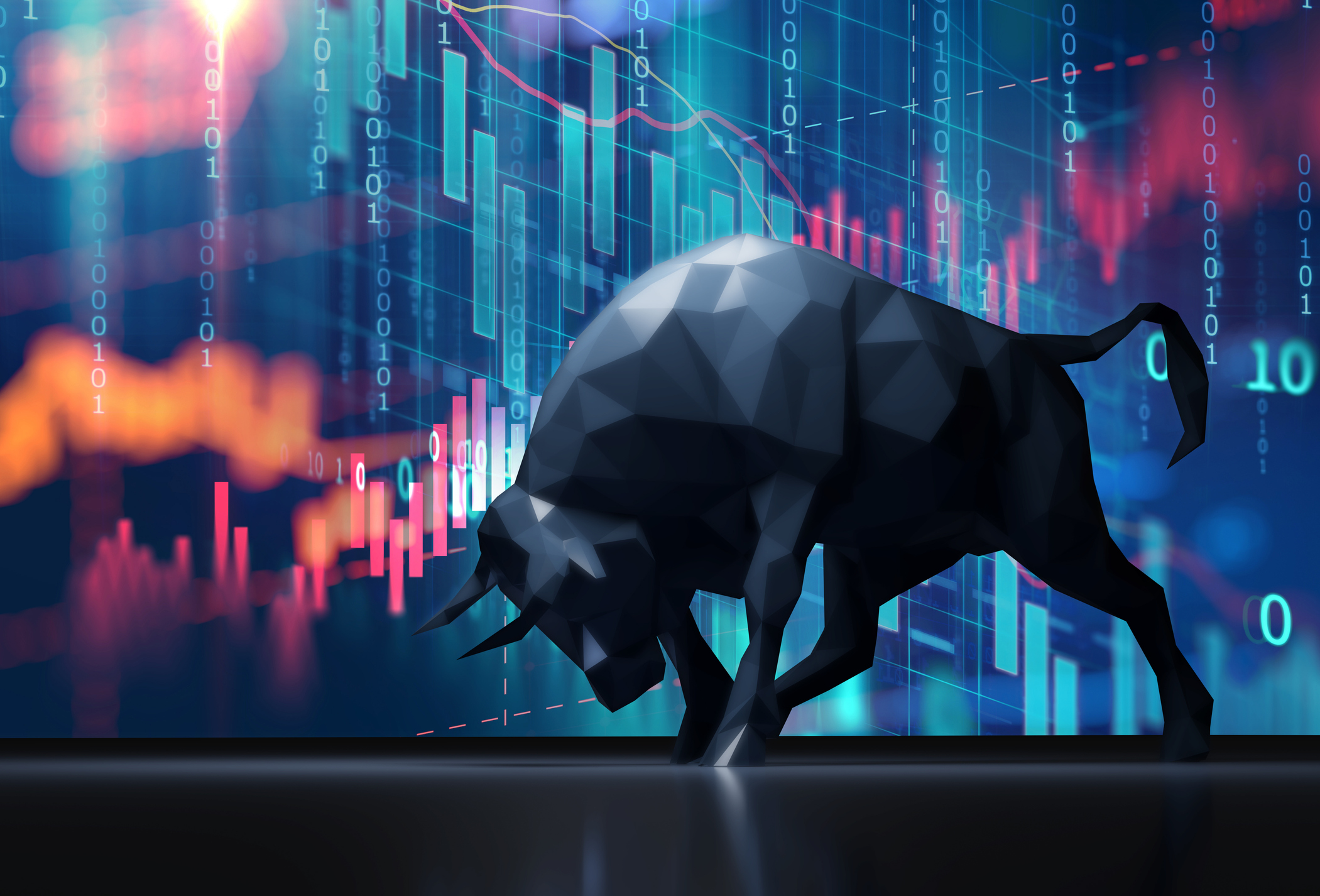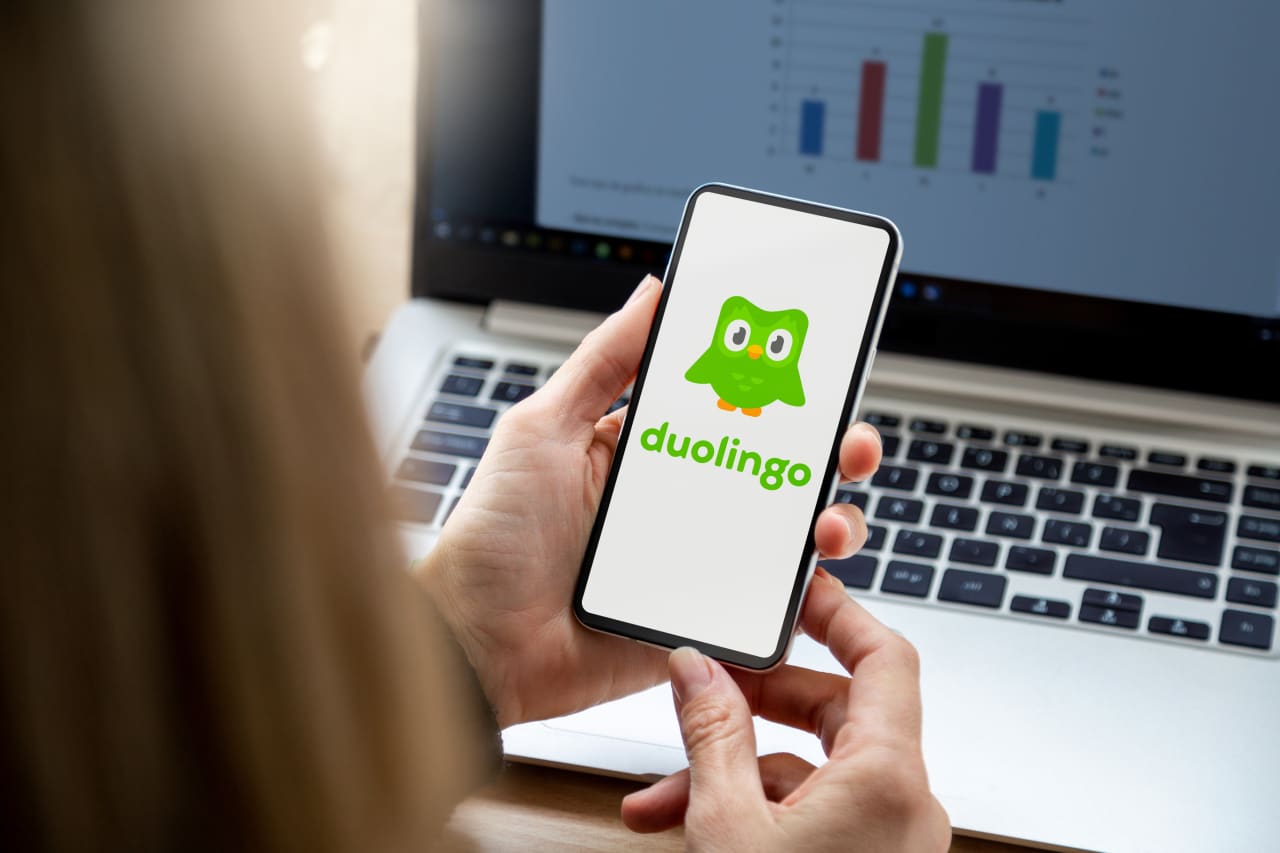The Best Stock Funds of 2023
The ‘Magnificent Seven’ tech stocks helped drive a rebound at many large-cap funds after a dismal 2022. The winner surged 65.2%.
Large-cap companies led the way in 2023, benefiting the money managers who believed in them.
Driven by a rebound in large and megacap stocks, in particular the “Magnificent Seven” technology companies, mutual-fund managers who saw double-digit losses in the market rout in 2022 found themselves rewarded for their patience this past year.
Nine of the top 10 stock funds in The Wall Street Journal’s Winners’ Circle survey of mutual funds, which covers the 12-month period ended Dec. 31, are in Morningstar’s large-cap growth category—often with big weightings in outperforming sectors such as technology, communications services and consumer discretionary. Those S&P 500 sectors notched total returns, including dividends, of 57.8%, 55.8% 42.4%, respectively, easily topping the broader market’s 26.3% result.
Still, the Magnificent Seven paced the market. These stocks—Alphabet, Amazon.com, Apple, Meta Platforms, Microsoft, Nvidia and Tesla—all gained more than 48% last year.
Nvidia, whose chips have become synonymous with exploding interest in artificial intelligence, was the biggest winner among those stocks with a gain of 239%. It was followed by Facebook parent Meta at 194% and Tesla at 102%. These were popular holdings among the top-performing funds in the latest survey, though it varied by the individual manager.
Excluding those stocks, the S&P 500’s return was only 9.9%, according to S&P Dow Jones Indices. In other words, the Magnificent Seven accounted for more than half of the index’s 2023 performance and boosted the returns of many funds as well.
Still, there was plenty of good performance across mutual funds, and it wasn’t always contingent on those seven stocks. A rising tide lifts most boats.
Survey parameters
For the latest 12-month period, more than 1,000 of the 1,191 funds tracked in the Journal’s survey made double-digit gains. The average fund returned 19.7%, and only four funds registered declines.

To qualify for inclusion in the Winners’ Circle, funds must be actively managed U.S.-stock funds with more than $50 million in assets and a record of three years or more, as well as meet a handful of other criteria. The survey excludes index and sector funds, funds that employ leverage strategies and most quantitative funds. The results are calculated by Morningstar Direct.
As always, this quarterly competition isn’t designed to create a “buy list” of funds for readers, but to demonstrate the ways that specific investment strategies benefited from recent market trends. Some of the funds that were highlighted a year ago have fallen in the rankings just as growth portfolios have grabbed the limelight—and that phenomenon isn’t uncommon.
Moreover, not all funds cited in these quarterly surveys may be available to investors, and they may have elements that make them unsuitable for some investors, ranging from their fee structure to their longer-term performance or volatility.
Take the latest No. 1 fund, for example. The $500 million Virtus Zevenbergen Innovative Growth Stock Fund (SAGAX) lost 55.4% in 2022 and 10.1% in 2021 as tech stocks tumbled amid the Federal Reserve’s rate-hike campaign and recession worry.
The fund returned 65.2% last year, however, thanks to the big turnaround for the large-cap growth stocks.
Patience paid off
“Markets and management teams spent all of 2022 fearing and preparing for a recession that has so far failed to appear, but that excess pessimism really swung the pendulum too far in terms of market sentiment,” says Joe Dennison, a portfolio manager of the Virtus fund. “That has created some great opportunities for patient long-term investors.”
It holds five of the Magnificent Seven, three of which—Tesla, Nvidia and Amazon—are among its top 10 holdings. Tesla, its largest holding, stands at 7.7% of the fund.
These stocks aren’t new to Dennison and his co-managers. The fund first bought shares of Nvidia in 2017. Its holdings in Tesla and Amazon date to 2010 and 2008, respectively.
Dennison says the biggest contributors to the fund’s 2023 performance besides Tesla and Nvidia were MercadoLibre, an e-commerce company in Latin America, and Shopify, an e-commerce business platform. Those stocks gained 86% and 124% last year, respectively.
The Virtus fund doesn’t shy away from high valuations. As of Dec. 29, the trailing price-to-earnings ratio of stocks it holds was 70.4, excluding negative earnings. This approach, however, can be volatile.
Indeed, Dennison acknowledges “there will be volatility and periods of underperformance,” but he adds that it’s important to focus on longer-term performance and stick with companies that the managers believe in.
Best of the rest
No. 2 in the latest survey, with a return of 59.1%, is the $290 million Value Line Larger Companies Focused Fund (VALLX), which holds all of the Magnificent Seven. They were initially put into the fund before 2023—though it did add to Amazon, Google parent Alphabet, Microsoft and Tesla in the first nine months of last year.
It trimmed its positions in Apple and Meta over that stretch.
The fund’s manager, Cindy Starke, says that 2023 was all about “adding to names that we had more conviction in,” rather than trying to unearth new stocks.
Starke looks for companies she thinks can increase sales at a three-year annualised compound rate of 10% or more and annualised earnings growth of at least 15% for three to five years.
She points out that the fund had broad stock appreciation last year: 25 of the holdings gained at least 50% over the year’s first three quarters. (That fund and others release quarterly holdings with a lag after the quarter ends, but performance is updated daily.)
Besides the Magnificent Seven, the fund’s winners included Uber Technologies, which appreciated 149% in 2023. It was put in the portfolio in the fourth quarter of 2021 and was the fund’s largest holding, at 6.5%, as of Sept. 30. Starke increased her holding in 2023.
When she added Uber to the fund in 2021, she recalls, “I just thought it was very undervalued” and that “the growth model would mature.”
Other top holdings include Nvidia, initially put into the fund in 2018; Microsoft (2020); Alphabet (2011) and Tesla (2021).
Two other big gainers for that fund: Advanced Micro Devices, which leapt 127% last year, and cybersecurity firm CrowdStrike Holdings, which rose 143%.
At the same time, Starke did plenty of selling. She trimmed the fund to 39 names from 47 over the first three quarters of 2023, jettisoning stocks such as Goldman Sachs, Walt Disney, Bank of America, Estée Lauder and Devon Energy. “I just got out of the names that didn’t offer me the same kind of growth opportunity,” she says.
Rounding out the top four funds are the $500 million Baron Fifth Avenue Growth Fund (BFTHX), which returned 57.2%, and the $11 billion Fidelity Blue Chip Growth K6 Fund (FBCGX), up 55.6%.
An outlier
A party crasher at No. 5 is the Morgan Stanley Inception Portfolio (MSSGX)—the lone fund in the top 10 outside of the large-cap growth category.
It toils in small-cap issues, which lagged behind large-caps last year. The Russell 2000 index of small stocks returned 16.9% in 2023, trailing the S&P 500 by nearly 10 percentage points.
But the Inception portfolio punched well above its weight, notching a return of 54.4%.
The fund’s managers aren’t afraid to make outsize bets. As of Sept. 30, its information-technology weighting was 38%, compared with 21.4% for the Russell 2000 Growth Index—the fund’s benchmark.
One of its best holdings as of Sept. 30 was Affirm Holdings, which runs a buy now, pay later platform. The stock gained more than 400 % last year.
But that small-cap fund is an outlier in the Winners’ Circle. It is the only one outside of the large-cap growth category among the top 24 finishers in the survey.
At No. 6 is the $25 billion Harbor Capital Appreciation Fund (HACAX), returning 53.7%. As of Sept. 30, the Magnificent Seven accounted for six of its top 10 holdings.
The fund’s managers did make some hay in healthcare, an unloved S&P 500 sector that otherwise eked out a 2.1% return last year, including dividends.
One such healthcare winner it held is Eli Lilly. The pharmaceutical company’s stock returned 61%, helped by its strong position in a nascent class of drugs for weight loss.
“We’re trying to find companies that can generate above-average growth rates sustainably over an investment cycle,” says Blair Boyer, a co-manager of the fund.
Another healthcare company that fit the bill for the fund is Novo Nordisk. Its portfolio includes the Wegovy weight-loss drug. The stock was up more than 50% last year.
The fund unloaded its positions in Thermo Fisher Scientific, which sells testing equipment and measurement tools to laboratories, and life-sciences company Danaher. Thermo Fisher Scientific’s stock fell 4%, and Danaher dropped by 2%.
One of the fund’s biggest sector bets last year was consumer discretionary, representing 25% of the fund at the end of the third quarter, compared with a 16% representation in the Russell 1000 Growth Index.
Shares of vacation-rental company Airbnb, another of the fund’s holdings, surged by 59%.
Ultimately, while large-caps mutual funds enjoyed the Magnificent Seven-led rebound last year, it’s impossible to say how they will fare in 2024 given uncertainty about the economy and the path of the Fed’s monetary policy.
But despite fickle market sentiment, managers of top-performing funds say the key to their success is patience and staying true to their strategy even when things look bleak, as in 2022.
“It was about staying the course, having the conviction and adhering to our investment philosophy in good times and bad,” says Starke of the Value Line fund.
 Copyright 2020, Dow Jones & Company, Inc. All Rights Reserved Worldwide. LEARN MORE
Copyright 2020, Dow Jones & Company, Inc. All Rights Reserved Worldwide. LEARN MORE
This stylish family home combines a classic palette and finishes with a flexible floorplan
Just 55 minutes from Sydney, make this your creative getaway located in the majestic Hawkesbury region.
Starting a new company with somebody requires a hard conversation. Better now than later.
You and a friend have a can’t-miss idea for a new business. You’ve got a great name, and the logo is perfect.
It is time to ask each other some hard questions.
Talking up front about tough subjects like how you work, how you deal with stress and your expectations for the business can save lots of headaches later. “Most issues are neutral when you discuss them ahead of time,” says Jane Brodsky , who ran a barre-and-spin studio with a partner for 10 years in Washington, D.C. “But in the heat of the moment, issues become personal and larger than they need to be.”
Here are crucial questions that should be settled at the start to help make the partnership succeed.
How did your family communicate?
Maybe you were raised in a family that talked through disagreements to find solutions. But maybe your partner grew up in a house where the loudest voice won. That could be a problem when issues arise in the business: Experts say that when people are under stress, they often fall back on behaviours that were imprinted at home—and different styles could clash.
At Happy Being, a company that sells nutritionally enhanced teas and drink powders, the three co-founders discussed communication style before they started the business. “We discovered that one partner gets triggered if he feels no one is listening,” says co-founder Dutch Buckley . “It goes back to an early fear of not being heard.” (For his part, co-founder Josemaria Silvestrini says that early on he “definitely needed the validation of being recognised and being right.”)
So, the three work at making sure everyone has a say in meetings, and they made a rule that no one’s work is ever belittled. On the flip side, when someone on the team accomplishes something, someone else on the team draws attention to it.
What does success look like to you? And failure?
While these may seem obvious—like, the business either succeeds or fails—everyone’s definition is different, and they are surprisingly specific. Certainly, monetary goals or anything that can be enumerated will help partners envision each other’s goals. Is one looking to grow slowly with customers and suppliers in the community and get to better than break even after three years, while the other wants to be cash-flow positive in year one and scale quickly to sell the business to a larger entity after 10 years? There’s a lot of success and failure in between those two outcomes, depending on your perspective.
Silvestrini of Happy Being recommends hashing it out together on the whiteboard until everyone agrees on an explicit definition of success for the company. “Hopefully, it’s an easy 10-minute conversation,” he says. “Because if founders have different objectives, the boat is going nowhere.”
What does everyone bring to the table?
It is crucial to discuss what each partner is contributing to the partnership in terms of expertise, experience, network and money. Kathryn Zambetti , an executive coach specialising in founder relationships, recommends taking an honest strengths-and-weaknesses inventory of yourself and your partner and then discussing what you both bring to the table. The exercise will help delineate which responsibilities naturally suit each partner, and it will highlight areas that will require additional work or outsourcing.
The clearer the roles can be defined, the better. If you are opening a bakery, you and your partner shouldn’t both be good at just making bread. Someone needs to handle marketing, suppliers, leases and licensing, financials and hiring and managing employees.
Why are you doing this?
You and your partner need to be in complete alignment on your motivations. Does this venture need to support your family or merely add to your vacation fund? Are you doing it to prove your father or your high-school econ teacher wrong? Any answer other than unfailing commitment to the mission or the product is a red flag.
“Your north star has to be something bigger than money to succeed,” says Buckley. “People will go through things that test them, but if money is the only motive, that won’t be enough.”
What pushes your buttons?
Just like in a marriage, you want to know best how to support and protect your business partner. Understanding what puts each of you in a fight-or-flight mode can be key to getting the best out of each other.
Do you need to be consulted on all decisions, or just major ones? Do you need to be recognized as the leader and sit at the head of the table? Do you fear having to downsize your home if the business fails?
What does your workday look like?
Does a day at the office mean working 9 to 5? Can the work be done remotely and on your own time? If you work well at night and need rapid responses to questions, is it a problem having a partner whose phone goes on “do not disturb” every evening at 7? Having the conversation and understanding expectations is key.
When Buckley started Happy Being, the team learned that one of the partners got up very early. “I had to tell him, ‘We don’t want 6 a.m. calls.’ ”
Do you like taking gambles?
A penchant for lottery tickets, Las Vegas gambling or high-adrenaline activities like skydiving shows a potential partner’s tolerance for risk and whether that aligns with your own. There will be countless decisions early on in a business concerning risk, and the partners need to be on the same page.
So ask about it. You go into the venture planning and hoping for success, but how much money or time is your partner willing to lose if it doesn’t succeed? How much of their parents’ or in-laws’ money would they bet on the partnership?
Is the business more important than the friendship?
Many business partners start as friends. But would you each be willing to give priority to making the right decision for the business, even if it means possibly hurting the friendship? Would you each be capable of letting the other one go if it was better for the company? Most advisers recommend choosing a partner who has a common business goal and letting the friendship build from that, rather than trying to build a partnership on top of a strong friendship.
“Your business partner will be one of your most intense relationships, but it shouldn’t fulfill every role in your life,” says Amy Jurkowitz, entrepreneur and co-founder of branding adviser Bread Ventures. “You need to be compatible in how much energy you will both put into the business.”
If the partnership doesn’t work out, how will it end?
A co-founder relationship is a binding agreement with financial and emotional repercussions, just like a marriage. But starting a business has the added stress of having the company—the baby—arrive on day one. If there is a divorce, who gets custody?
The more specific you can be about potential breakups, the better. If you are both putting capital in at the start, would you expect to get that out if you exited? What if, several years in, one partner can’t continue to struggle without a regular paycheck and leaves—and the next year the company finally turns a profit or is bought by another company? Would the partner who left get a share of the money?
These discussions should help make it clear that the survival of the company—and not the partnership or the friendship—is the ultimate goal. Those who have been through a business breakup recommend involving a third party to help sort through these issues at the outset.
This stylish family home combines a classic palette and finishes with a flexible floorplan
Consumers are going to gravitate toward applications powered by the buzzy new technology, analyst Michael Wolf predicts























